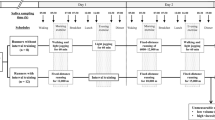Abstract
Introduction
The cortisol, cortisone, corticosterone, and CBG responses to exercise in the AM and PM have not been described. This study examined the response of these glucocorticoids and CBG to intense exercise in 12 endurance-trained men in plasma (Pl) and saliva (Sa).
Methods
Each subject completed treadmill exercise in the morning and evening. Paired blood and Sa samples were obtained at rest before and after exercise.
Results
Significant time effect existed for Pl-cortisol and Sa-cortisol from baseline in the AM and PM (p < 0.01). Pl-cortisone and CBG significantly increased in the PM (p < 0.01). Pl-corticosterone increased in the AM and PM (p < 0.01). Unlike Pl-cortisone, Sa-cortisone was significantly higher in the AM compared to the PM, increasing in the AM and PM (All p < 0.01). Strong associations were found between Pl-cortisol and Sa-cortisol (r = 0.81, p < 0.0001), Pl-cortisol and Sa-cortisone (r = 0.81, p < 0.0001).
Conclusions
(1) Intense EX induces a similar increase in Pl-cortisone (~90 %) and corticosterone (~200 %) in the AM and PM, whereas exercise increases CBG in the PM, but not in the AM; (2) vigorous exercise increases Sa-cortisone; (3) Sa-cortisone and cortisol are equally strongly correlated to Pl-cortisol, suggesting a significant role for Sa-cortisone as a novel marker of free cortisol during exercise.




Similar content being viewed by others
References
Bonte HA, van den Hoven RJ, van der Sluijs Veer G, Vermes I (1999) The use of free cortisol index for laboratory assessment of pituitary–adrenal function. Clin Chem Lab Med 37:127–132
Chapman K, Holmes M, Seckl J (2013) 11β-hydroxysteroid dehydrogenases: intracellular gate-keepers of tissue glucocorticoid action. Physiol Rev 93:1139–1206
Cohen J, Cohen P, West S, Aiken L (2003) Applied multiple regression/correlation analysis for the behavioral sciences, vol 310, 3rd edn. Lawrence Erlbaum Associates Inc, Mahwah, pp 49–50
Coolens JL, Van Baelen H, Heyns W (1987) Clinical use of unbound plasma cortisol as calculated from total cortisol and corticosteroid-binding globulin. J Steroid Biochem 26:197–202
Crewther BT, Lowe TE, Ingram J et al (2010) Validating the salivary testosterone and cortisol concentration measures in response to short high-intensity exercise. J Sports Med Phys Fit 50:85–92
Davies CTM, Few JD (1973) Effects of exercise on adrenocortical function. J Appl Physiol 35:887–891
Del Corral P, Mahon AD, Duncan GE et al (1994) The effect of exercise on serum and salivary cortisol in male children. Med Sci Sports Exerc 26:1297–1301
Di Luigi L, Botrè F, Sabatini S et al (2014) Acute effects of physical exercise and phosphodiesterase’s type 5 inhibition on serum 11β-hydroxysteroid dehydrogenases related glucocorticoids metabolites: a pilot study. Endocrine 47:952–958
Di Luigi L, Sgrò P, Baldari C et al (2012) The phosphodiesterases type 5 inhibitor tadalafil reduces the activation of the hypothalamus–pituitary–adrenal axis in men during cycle ergometric exercise. Am J Physiol Endocrinol Metab 302:E972–E978
Follenius M, Brandenberger G (1986) Plasma free cortisol during secretory episodes. J Clin Endocrinol Metab 62:609–612
Fryer SM, Dickson T, Hillier S, Stoner L, Scarrott C, Draper N (2014) A comparison of capillary, venous and salivary cortisol sampling following intense exercise. Int J Sports Physiol Perform 9:973–977
Gatti R, De Palo EF (2011) An update: salivary hormones and physical exercise. Scand J Med Sci Sports 21:157–169
Kanaley JA, Weltman JY, Pieper KS et al (2001) Cortisol and growth hormone responses to exercise at different times of day. J of Clin Endrocrinol Metab 86:2881–2889
Methlie P, Husebye EE, Hustad S, Lien EA, Løvås K (2011) Grapefruit juice and licorice increase cortisol availability in patients with Addison’s disease. Eur J Endocrinol 165:761–769
Perogamvros I, Keevil BG, Ray DW, Trainer PJ (2010) Salivary cortisone is a potential biomarker for serum free cortisol. J Clin Endocrinol Metab 95:4951–4958
Perogamvros I, Ray DW, Trainer PJ (2012) Regulation of cortisol bioavailability-effects on hormone measurement and action. Nat Rev Endocrinol 8:717–727
Port K (1991) Serum and saliva cortisol responses and blood lactate accumulation during incremental exercise testing. Int J of Sports Med 12:490–494
Qian X, Droste SK, Gutièrrez-Mecinas M et al (2011) A rapid release of corticosteroid-binding globulin from the liver restrains the glucocorticoid hormone response to acute stress. Endocrinology 152:3738–3748
Raubenheimer PJ, Young EA, Andrew R, Seckl JR (2006) The role of corticosterone inhuman hypothalamic–pituitary–adrenal axis feedback. Clin Endocrinol (Oxf) 65:22–26
Rowbottom DG, Keast D, Garcia-Webb P, Morton AR (1995) Serum free cortisol responses to a standard exercise test among elite triathletes. Aust J Sci Med Sport 27:103–107
Gaebelein CJ, Senay LC (1980) Influence of exercise type, hydration, and heat on plasma volume shifts in men. J Appl Physiol Respir Environ Exerc Physiol. 49:119–123
Thomasson R, Baillot A, Jollin L, Lecoq AM, Amiot V, Lasne F, Collomp K (2010) Correlation between plasma and saliva adrenocortical hormones in response to submaximal exercise. J Physiol Sci 60:435–439
Thuma JR, Gilders R, Verdun M, Loucks AB (1995) Circadian rhythm of cortisol confounds cortisol responses to exercise, implications for future research. J Appl Physiol 78:1657–1664
Acknowledgments
The authors would like to thank Edward T. Howley, PhD, Robin Rylaarsdam, PhD, and Hugo Eiler DVM, PhD for reviewing an earlier draft of the manuscript.
Author information
Authors and Affiliations
Corresponding author
Ethics declarations
Conflict of interest
The authors declare that no conflict of interest exists.
Ethical approval
All procedures performed in studies involving human participants were in accordance with the ethical standards of the institutional and/or national research committee and with the 1964 Helsinki declaration and its later amendments or comparable ethical standards.
Informed consent
Each subject completed a medical history questionnaire and was asked to read and ask questions, before signing an informed consent form approved by the Institutional Review Board of Benedictine University.
Rights and permissions
About this article
Cite this article
Del Corral, P., Schurman, R.C., Kinza, S.S. et al. Salivary but not plasma cortisone tracks the plasma cortisol response to exercise: effect of time of day. J Endocrinol Invest 39, 315–322 (2016). https://doi.org/10.1007/s40618-015-0367-7
Received:
Accepted:
Published:
Issue Date:
DOI: https://doi.org/10.1007/s40618-015-0367-7




